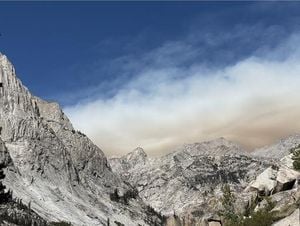NASA has been keeping its eyes peeled after the recent alert about two massive asteroids, 2024 OJ2 and 2024 OC, heading toward our planet. While rocketing through space may sound thrilling, these extraterrestrial visitors can cause quite the stir - and not always for the best reasons. Both asteroids are reminders of the potent cosmic forces at play just beyond our atmosphere.
The larger of the two, asteroid 2024 OC, measures about 410 feet wide, close to the size of a large building. It’s scheduled to make its closest approach to Earth on August 4, zipping by at blistering speeds of approximately 35,986 kilometers per hour (about 22,360 miles per hour). That’s fast enough to give anyone pause and evoke thoughts of disaster movie plotlines where Earth faces calamity from the skies.
NASA has been relentless with its monitoring efforts, making sure this rock doesn’t shake up life on Earth. Luckily, asteroid 2024 OC will be gliding by safely at around 7.4 million kilometers away, which is more than enough distance to prevent any catastrophic event. Still, there’s always the “what if” scenario floating around. What if it were to collide with Earth? Such impacts can be devastating, resulting not just in craters but possibly contributing to widespread destruction and loss of life depending on where these rocks land.
Then there’s 2024 OJ2, another asteroid making its approach just days before OC. This one measures about 110 feet, and though significantly smaller, it carries its own momentum at around 37,510 kilometers per hour (over 23,000 miles per hour). Like its larger counterpart, it will also safely pass Earth at roughly 4.45 million miles, so scientists seem poised for yet another harmless flyby.
Asteroids may not always be headline-grabbers weekly, but they certainly deserve attention. They are considered minor planets made from the leftover materials from the early solar system, dating back approximately 4.6 billion years. These ancient rocks orbit within the inner regions of our solar system and often act as unintended warnings of the geophysical risks we face from outer space.
NASA and many scientific organizations devote considerable resources to studying these near-Earth objects (NEOs) because they want to project their trajectories and assess any risks. Regularly, these rocks can interfere with the daily doings of Earth, as remnants have struck our planet through the ages. Some think back to the infamous Chicxulub impact, which played its role directed toward the extinction of the dinosaurs around 66 million years ago.
The characteristics of the study of asteroids, like 2024 OC and 2024 OJ2, include how frequently they zoom past us and how their movements can affect our planet over long periods. Such investigations provide valuable insight beyond just tracking potential threats; they also equip scientists with knowledge about the structure, composition, and history of these asteroids.
Asteroids don’t shoot across the skies aimlessly. They have orbits, and many are classified as potentially hazardous asteroids (PHOs) if they are larger than 140 meters and approach Earth within 7.5 million kilometers. This classification allows authorities like NASA to keep close tabs as these space rocks race through the solar system. Of course, not all asteroids are considered dangerous. Most pass by harmlessly and provide unique opportunities for scientists to gather data.
On occasions when significant asteroids approach Earth, missions may be launched to assess the situation. These entities represent more than just risks. They also provide learning opportunities, help fuel advances in planetary defense systems, and spur development for potential future missions aimed at redirecting hazardous objects.
Through diligent monitoring and research, organizations are confident we can handle any asteroid situation. And as astronomers continue to observe the cosmos, each flyby of 2024 OC and 2024 OJ2 can serve as a reminder of both the beauty and peril lurking beyond our atmosphere.
Asteroids are fascinating, yet sometimes frightening. They remind humanity of the delicate balance of existence on Earth and the vast universe surrounding us. Whether they are near misses, like 2024 OJ2, or larger threats, like 2024 OC, every observation is critical for scientific advancement and the safeguarding of our planet. Keeping the line of communication open between space agencies and the public is also pivotal as researchers work to educate everyone on the nature of these surprising visitors.
For now, it seems like we can breathe easy, at least until the next asteroid roll call. But if space rocks should become more active, we’ll be ready, armed with technology and knowledge. Isn’t it amazing to think how we can monitor the universe and stay safe all thanks to human ingenuity?



